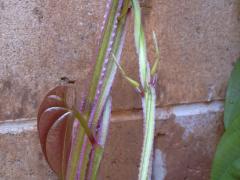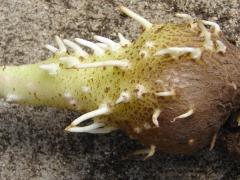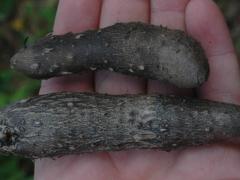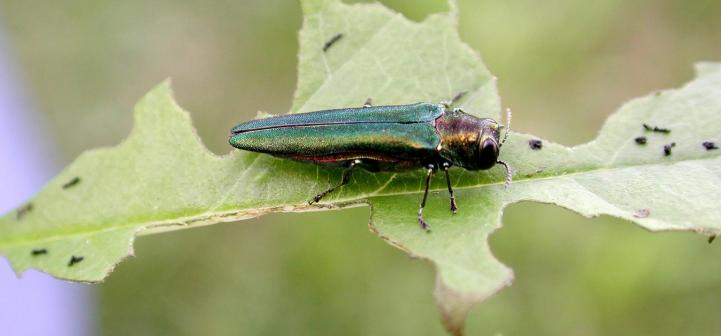Invasive Species: Dioscorea alata, Winged Yam
Winged yam is an invasive herbaceous, twining vine that can grow to lengths exceeding 30 ft. (9.1 m). It invades open to shady areas in the extreme southeastern United States. Leaves are opposite, 8 in. (20.3 cm) long, and narrowly heart-shaped with long petioles. The stems are square with the corners compressed into wings. The vine rarely flowers. The seeds are winged all around. The chief means of reproduction is by aerial potato-like tubers (bulbils) located at the leaf axils and by underground tubers. Winged yam can form dense masses of vines that cover and kill native vegetation, including trees. It was introduced from Asia as a possible food source in the early 1800s. In some countries it is presently being cultivated for medicinal uses.
What are invasive species and why should we be concerned about them?
Taxonomy: Scientific and Common Names for This Species
Dioscoreales > Dioscoreaceae > Dioscorea alata L.
Synonym(s): water yam
Dioscorea alata – USDA PLANTS Profile
Distribution Maps
Winged yam – The reported distribution of this invasive species across the United States (Source: Invasive Plant Atlas of the United States)
Up-to-the-minute distribution maps and why they are important
Reporting This Invasive Species
What is the best way and place to report the occurrence of an invasive species?
How to report an invasive species sighting to EDDMapS – Early Detection & Distribution Mapping System?
EDDMapS – Report an invasive species to EDDMapS.
Cooperative Extension Offices – Find your local Cooperative Extension office on this map provided by USDA.
How to Identify
This invasive species can be identified by looking for the characteristics described in the paragraphs that follow.
Vine
Winged yam is an herbaceous, twining vine that can grow to lengths exceeding 30 ft. (9.1 m).
 |
 |
| Forest & Kim Starr, Starr Environmental, bugwood.org | Chris Evans, River to River CWMA, bugwood.org |
Foliage
Leaves are opposite, 8 in. (20.3 cm) long, and narrowly heart-shaped with long petioles. The stems are square with the corners compressed into wings.
|
|
 |
| Forest & Kim Starr, Starr Environmental, bugwood.org | Chris Evans, River to River CWMA, bugwood.org |
Flower
The vine only rarely produces small white flowers.
 |
 |
| Forest & Kim Starr, Starr Environmental, bugwood.org | Forest & Kim Starr, Starr Environmental, bugwood.org |
Fruit
The seeds are winged all around. The chief means of reproduction is by aerial potato-like tubers (bulbils) located at the leaf axils and by underground tubers.
 |
 |
| Forest & Kim Starr, Starr Environmental, bugwood.org | Chris Evans, River to River CWMA, bugwood.org |
Native Species That Can Resemble Winged Yam
Dioscorea villosa, wild yam – Images at Invasive.org
 |
 |
| Karan A. Rawlins, University of Georgia, bugwood.org | Karan A. Rawlins, University of Georgia, bugwood.org |
Dioscorea quaternata, fourleaf yam – Images at Invasive.org
 |
|
| Chris Evans, River to River CWMA, bugwood.org | bugwood.org |
Additional Images for Winged Yam
Winged yam – Images at Invasive.org
Learning Resources for Winged Yam
Additional Information, Biology, Control and Management Resources
Control and management recommendations vary according to individual circumstances. Location, habitat, weather, and a variety of other conditions are factors that help determine the best treatment choice. To find the safest and most effective treatment for your situation, consult your state’s land-grant institution. If you will use chemicals as part of the control process, always refer to the product label.
United States Land-Grant University System – Find your land-grant university’s college of agriculture, Cooperative Extension office, or other related partner on this map provided by USDA.
A Field Guide for the Identification of Invasive Plants in Southern Forests – USDA Forest Service
A Management Guide for Invasive Plants of Southern Forests – USDA Forest Service
Identification and Biology of Non-Native Plants in Florida’s Natural Areas – University of Florida
Element Stewardship Abstract – The Nature Conservancy

